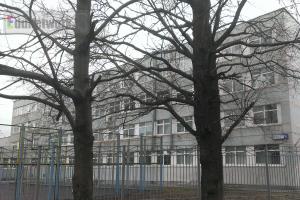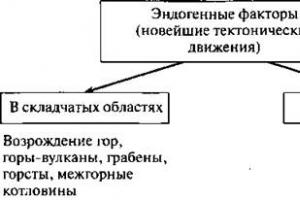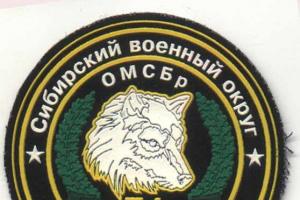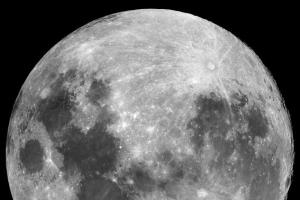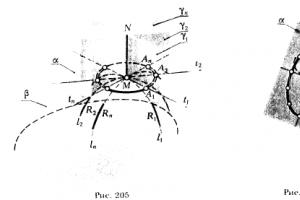8th grade
Option 1
1. In which of the following eras did plants and animals appear?
1) The age of the Earth is about 5 billion years.
3.What is the name of the top layer of the platform, consisting of limestone, clay, sandstone?
a) basaltic c) sedimentary
b) granite d) limestone
4. Stable areas of the earth’s crust are called:
a) platforms b) shields
b) folded areas d) avalanche
5.The plains are located on:
a) platform b) in folded areas
b) boundaries of lithospheric plates d) on shields
6.Ranges rose into the Mesozoic folding:
a) Altai c) Sikhote-Alin
b) Caucasus d) Urals
7. Deposits are confined to ancient folded areas:
a) coal, oil, gas c) uranium
b) iron ores, gold d) table salt
8.What is the science of minerals called?
b) paleontology d) geology
9. Establish a correspondence between the mountains and their highest peaks:
1. Caucasus a) Pobeda
2. Altai b) Belukha
3. Sayan Mountains c) Elbrus
4. Chersky ridge d) Munku-Sardyk
10. The structure of the earth’s crust is shown on the map:
11. Underwater earthquakes often occur here, which generate tsunamis in the Pacific Ocean:
a) Sakhalin c) Kamchatka
b) Madagascar d) Byrranga
12.Name the largest coal basin.
a) Vladimir c) Yakut
b) Kuznetsky d) Kursk
13.Where are diamonds mined in Russia?
a) Tunguska basin c) Yakutia
b) Lena basin d) Buryatia
14.What are the names of the areas within which there are a large number of deposits of the same type of minerals?
a) deposit c) blockage
b) storage d) pool
15. The most severe region of our country, its relief is represented by medium-altitude mountains of middle age.
16.What is rich in the Tunguska basin in Eastern Siberia?
a) gas b) coal
b) oil d) furs
17.Where in Russia can you find echoes of an ancient glacier?
a) Far East c) Yakutia
b) Valdai Hills d) Karelia
18. The main destroyer and creator of the nature of the Caspian lowland is
a) pressure b) precipitation
b) wind d) air temperature
19. In what geological period of what geological era did we finish studying the topic “Geological structure and relief of Russia”?
a) Cambrian c) Neogene
b) Cretaceous d) Quaternary
20.What platform is the school you are on?
a) Russian c) Amur
Cartographic workshop
8th grade
Test work on the topic “Geological structure and relief”
Option 2
1. In which of the listed eras did reptiles appear to dominate?
a) Cenozoic c) Paleozoic
b) Mesozoic d) Proterozoic
2.Are the following statements true?
1) The age of the Earth is about 8 billion years.
2) The Great Glaciation influenced both the diversity of flora and fauna, as well as the topography of the earth’s surface.
a) only 1 statement is true c) both statements are true
b) only 2 statements are true d) both statements are wrong
3.What is the name of the lower tier, representing the base of the platform?
a) base c) foundation
b) shield d) horst
4. The mountains are located in ……. areas
a) platform b) folded
b) weathered d) foundation
5. In what era did the Caucasus Mountains begin to form?
a) Alpine c) Hercynian
b) Baikal d) Caledonian
6.What mountains were formed during the Caledonian and Hercynian folds between ancient platforms and gradually began to collapse?
a) Altai c) Sikhote-Alin
b) Caucasus d) Ural
7.What minerals are located in folded areas?
a) coal b) oil
b) iron and copper ores d) gas
8.What is the name of the doctrine of the structure of the earth’s crust and its movements?
a) petrography c) geotectonics
b) paleontology d) geology
9. Establish a correspondence between the mountains and their peaks:
1. Caucasus a) Ichinskaya Sopka
2. Altai b) Belukha
3. Sayan Mountains in) Dykhtau
4. Kamchatka d) Munku-Sardyk
10. Map with information about the age of breeds:
a) physical b) tectonic
b) geological d) climatic
11.Where is the only area of modern volcanism in the country located?
a) Sakhalin c) Kamchatka
b) Kuril Islands d) Byrranga
12.What is the name of the richest iron ore basin on the planet?
a) KMA c) KMZH
b) BZhB d) KAM
13.What is the Udokan deposit of Transbaikalia rich in?
a) potassium salts c) oil
b) gold d) copper ore
14.Useful substances are not scattered throughout the earth’s crust, but are concentrated in certain areas of it, which are called...
a) deposit c) deposits
b) storage d) pool
15.What natural area are we talking about: “No other region of our country has such a huge extent from north to south. The youngest mountains in Russia are located here.”
a) North-East Siberia c) Ural
b) Far East d) Western Siberia
16.What is the Kuznetsk basin rich in?
a) coal b) gas
b) oil d) diamonds
17.What are the names of mud-stone flows that arise as a result of heavy rains?
a) avalanche c) mudflows
b) moraine d) collapsing cobblestones
18.Which Russian village was completely destroyed in 1995 as a result of a strong earthquake?
a) Neftekamsk c) Neftegaz
b) Neftegorsk d) Severodvinsk
19. In what geological period of what geological era did you study the topic “Russian explorers of the 11th – 17th centuries”?
a) Cambrian c) Neogene
b) Cretaceous d) Quaternary
20.Which platform did you have breakfast on today?
a) Russian c) Amur
b) West Siberian d) North American
Cartographic workshop
Identify the geographical objects depicted on fragments of the map of Russia.
8th grade
Test work on the topic “Geological structure and relief”
ANSWERS
CARTOGRAPHIC ASSESSMENT PRACTICUM
Option 1 Option 2 “5” - 10 - 9
"4" - 8 -7
"3" - 6 - 5
1.Russian Plain 1.Caspian Lowland
2. Sayan Mountains 2. Timan Ridge
3.g. Khibiny 3. Central Siberian Plateau
4. Aldan Highlands 4. Ural
5.Verkhoyansk ridge 5.g. Byrranga
6, Altai 6. Sikhote - Alin ridge
7.West Siberian Plain 7.West Sakhalin Mountains
8.Caucasus 8.Sayans
9. Sredinny ridge 9. ridge. Dzhugjur
10. Chersk ridge 10. Valdai Upland
ANSWERS ASSESSMENTS
Option 1 Option 2 "5" - 20 - 18
1.A 1.B “4” - 17 - 14
2.B 2.B “3” - 13 - 9
3.B 3.AB
4.A 4.B
5.A 5.A
6.B 6.D
7.A 7.B
8.A 8.B
9.1V,2B,3G,4A 9.1V,2B,3G,4A
10.B 10.B
11.AB 11.VB
12.B 12.A
13.B 13.G
14.G 14.A
15.A 15.B
16.B 16.A
17.VG 17.V
18.B 18.B
19.G 19.G
20.A 20.A
- (Pacific folding, Yenshan folding), the era of tectogenesis, which appeared during the Mesozoic era mainly along the periphery of the Pacific ca. The main phases are Cimmerian (late Jurassic, early Cretaceous; Crimea and northeast Russia), Laramian (late... ... Big Encyclopedic Dictionary
Mesozoic folding- The era of mountain building, which manifested itself during the Mesozoic era mainly along the periphery of the Pacific Ocean, the main phases being the Cimmerian and Laramie folds... Dictionary of Geography
- (Pacific folding, Yenshan folding), an era of tectogenesis that appeared during the Mesozoic era mainly along the periphery of the Pacific Ocean. The main phases are Cimmerian (end of the Jurassic, beginning of the Cretaceous; Crimea and North-East Russia), ... ... encyclopedic Dictionary
A set of geological processes of folding, mountain building and granitoid magmatism that occurred during the Mesozoic era. It manifested itself most intensively within the Pacific Mobile Belt. There are foldings: ... ... Geographical encyclopedia
- (Pacific folding, Yeishan folding), the era of tectogenesis, which appeared during the Mesozoic era ch. arr. on the periphery of the Pacific approx. Ch. phases Cimmerian (end of the Jurassic - beginning of the Cretaceous; Crimea and N.V. Russia), Laramian (end of the Cretaceous - beginning ... ... Natural science. encyclopedic Dictionary
Appeared during the Mesozoic era, ch. arr. within the Pacific Mobile Belt. Recently (and by some tectonists even now) the S. m. was considered as part of the Alpine folding. The main phases of S. m. appeared non-simultaneously in... ... Geological encyclopedia
Option 1.
1) 5895 m 2) 6960 m 3) 5642 m
2. Mountains in Russia occupy about...
1) third part of the territory
2) a quarter of the territory
3) half the territory
3. The longest mountain structure in Russia is...
1) Caucasus 2) Sikhote-Alin 3) Ural
4. The foundation of the most ancient platforms in Russia has... age
1) Paleozoic 2) Precambrian 3) Mesozoic
5. The foundation of the Siberian platform comes to the surface in the form of shields...
1) Baltic and Anabar 3) Aldan and Anabar
2) Aldan and Baltic
6. The foundation of the West Siberian young platform was formed simultaneously with...
1) the Urals 2) the Caucasus 3) Sikhote-Alinem
7. In the first half of the Paleozoic, ... folding occurred
1) Alpine 2) Caledonian 3) Hercynian
8. At the boundaries of modern lithospheric plates,…
1) Koryak Highlands and Kamchatka Mountains 3) Timan Ridge and the Urals
2) Ural and Taimyr mountains
9. During the Mesozoic folding, a folded base was formed...
1) ridges: Chersky, Verkhoyansk, Sikhote-Alin
2) Caucasus, Koryak Highlands, Sakhalin
3) Urals, Altai, Sayan
10. The height of mountains depends on...
1) the rate of uplift of the earth’s crust
2) speed of relief destruction
3) the relationship between the rate of uplift and the rate of destruction
11. The Caucasus is higher than Altai because...
1) formed later
2) composed of harder rocks
3) experiences a more intense rise
12. The gully-gully network on the East European Plain is the most developed...
1) on the Caspian lowland 3) on the Valdai Upland
2) on the Central Russian Upland
13. The relief created by river sediments is the most widespread...
1) on the West Siberian Lowland 3) on the Central Siberian Plateau
2) on the East European Plain
14. Active volcanoes in Russia are located...
1) in the Caucasus
2) in the Urals
3) in Kamchatka and the Kuril Islands
15. There are minerals on the platforms...
1) only of igneous origin
2) igneous and sedimentary origin
3) igneous, sedimentary and metamorphic origin
Relief, geological structure.
Option 2.
1. The highest point of Russia is located within…
1) Caucasus 2) Altai 3) Sayan
2. The highest and most dissected plain in Russia is...
1) East European Plain
2) Central Siberian Plateau
3) West Siberian Plain
3. The relief of the East European Plain is an alternation...
1) plateaus and hills
2) highlands and lowlands
3) lowlands and plateaus
4. On ancient platforms there are…
1) East European and West Siberian Plains
2) West Siberian Plain and Central Siberian Plateau
3) Central Siberian Plateau and East European Plain
5. The foundation of the East European Platform comes to the surface in the form of ... a shield
1) Baltic 2) Anabar 3) Aldan
6. In the second half of the Paleozoic, ... folding occurred
1) Caledonian 2) Hercynian 3) Baikal
7. On the boundaries of modern lithospheric plates are located... the outskirts of Russia
1) northern 2) western 3) eastern
8. In the Paleozoic folding, a folded base arose...
1) Caucasus and Urals
2) Urals and Altai
3) Verkhoyansk ridge and Sikhote-Alin
9. The restored fold-block mountains include: ...
1) Ural, Altai, Sayan Mountains 2) Sayan Mountains, Koryak Highlands, Kamchatka Mountains
2) Caucasus, Sikhote-Alin, Altai
10. If the rate of uplift of the earth’s crust is equal to the rate of destruction, then...
1) mountains 2) depressions 3) plains
11. Moraine relief was formed as a result of geological activity...
1) wind 2) flowing water 3) glacier
12. Quaternary glaciations on the territory of Russia spread most south...
1) in the European part 3) in the Far East
2) in Siberia
13. Areas where strong earthquakes occur in Russia are...
1) Ural, Central Siberian Plateau
2) Kola Peninsula, West Siberian Lowland
3) Kamchatka, Kuril Islands, Caucasus
14. The largest active volcano in Russia...
1) Kronotskaya Sopka 3) Avachinskaya Sopka
2) Klyuchevskaya Sopka
15. The mountains are dominated by minerals...
1) ore igneous
2) ore sedimentary
3) flammable (oil, gas, coal)
Objectives: to introduce the influence of internal and external factors on the formation of relief; show the continuity of relief development; consider the types of natural phenomena, the causes of their occurrence; talk about the influence of man on the terrain.
Equipment: physical map, tables, pictures, video about natural phenomena, books, diagrams.
During the classes
I. Organizational moment
II. Checking homework
1. Repetition of terms and concepts
Platform, shield, folded region, tectonics, paleontology, deposit.
Option 1
1. Stable areas of the earth’s crust are called:
a) platforms;
c) folded areas.
2. The plains are located:
a) at the boundaries of lithospheric plates;
b) on platforms;
c) in folded areas.
3. The mountains are located:
a) on platforms;
b) on slabs;
c) in folded areas.
4. The following ridges rose into the Mesozoic folding:
b) Sikhote-Alin;
c) Caucasus.
5. The reborn mountains are:
b) Caucasus;
6. Deposits are confined to ancient folded areas:
a) coal, oil, gas;
b) iron ores, gold;
c) both.
7. The largest coal basins are:
a) Samotlor, Kansko-Achinsky;
b) Tunguska, Lensky;
c) Urengoy, Yamburg.
8. Landforms of glacial origin include:
a) moraines, trogs, sheep's foreheads;
b) ravines, beams;
c) barchans, dunes.
9. The surface of Russia goes down:
b) to the north;
c) to the west;
d) to the east.
Answers: 1 - a; 2 - b; 3 - in; 4 - b; 5 - a; 6 - b; 7 - b; 8 - a;
Option 2
a) Proterozoic;
b) Paleozoic;
c) Archean.
2. The geological era, which continues today, is called:
a) Mesozoic;
b) Cenozoic;
c) Paleozoic.
3. The science of minerals is called:
a) petrography;
b) paleontology;
c) geotectonics.
4. Find a correspondence between the mountains and their highest peaks:
1) Caucasus: a) Victory;
2) Altai; b) Belukha;
3) Sayans; c) Elbrus;
4) Chersky ridge. d) Munku-Sardyk.
5. Choose the correct statements:
a) large plains are located on platforms;
b) aeolian processes create moraines:
c) the Kamchatka peninsulas and the Kuril Islands - the most seismically active zones in Russia;
d) the main part of the mountains is located in the west and north of Russia;
e) the Ural Mountains are located between the Russian and West Siberian plains.
6. Find correspondence between concepts and their definitions:
1) mud-stone flow;
2) snow melting from mountain slopes;
3) loose clay-boulder glacial deposits.
a) avalanche;
c) moraine,
7. Which map shows the structure of the earth's surface (crust)?
a) on the physical;
b) on geological;
c) on tectonic.
Answers: 1 - in; 2 - b; 3 - a; 4 - 1) c, 2) b, 3) d, 4) a; 5 - a, c, d; 6 - 1) b, 2) a, 3) c; 7 - c.
III. Learning new material
(The following concepts are written on the board: endogenous processes, exogenous processes, volcanism, earthquakes, recent tectonic movements, glaciation, moraines, aeolian relief, dunes, screes, landslides, avalanches, mudflows, erosion.)
Look at the blackboard. We will look at these terms today in class, and remember some of them.
The relief is constantly changing under the influence of exogenous (external) and endogenous (internal) factors.
(The teacher draws a diagram on the board while giving explanations.)
The relief is constantly changing under the influence of exogenous (external) and endogenous (internal) factors. Both of these factors act simultaneously.
Endogenous processes are called neotectonic or recent. They can appear in both mountains and plains.

In the mountains, movements of the earth's crust are most active. In the Caucasus, movements occur at a speed of 5-8 cm per year; in young mountains, where the earth's crust is plastic, movements are accompanied by the formation of folds. In areas of ancient folding (Urals, Altai, Sayans, etc.), where the earth's crust is more rigid, faults and normal faults are formed. The areas undergo vertical movements, some blocks rise, others fall, forming intermountain basins.
On the platforms, the latest movements are manifested in centuries-old slow fluctuations of the earth's crust, some areas slowly rising, while others are falling at a rate of about 1 cm per year. But there can also be faults on platforms, an example of this is the faults in eastern Africa (Great African Rifts).
Exogenous processes are processes that occur under the influence of flowing waters (rivers and glaciers, mudflows), permafrost, and wind.

Glacial landforms
During the Quaternary period, a huge shell of ice up to 4 km thick buried almost all of Europe. The centers of glaciations were Scandinavia, the Polar Urals, the Putorana Plateau and the Byrranga Mountains on the Taimyr Peninsula. The cold was advancing on the Earth in giant waves. There were several such waves. The formation of glaciers is associated with them. Since the Cambrian, scientists have counted up to five such glaciations. At the beginning of the Quaternary period, the great glaciation began for the fifth time. This happened more than 200 thousand years ago. The glacier retreated relatively recently - only 12-15 thousand years ago.
1. Moraine (French moraine) - a geological body composed of glacial deposits. The boulders in moraines consist mainly of granites and gneisses. In addition to rounded boulders, on the surface of the moraine there are sometimes large, up to several tens of meters in diameter, poorly rounded boulders of rapakivi granites - outliers. The colossal boulder is widely known, which was used as a pedestal for the installation of the monument to Peter 1 in St. Petersburg. This boulder, called the “Thunder Stone,” was found near the village of Lakhta on the shores of the Gulf of Finland. Its length is 13 m, width - 7 m, height - 8 m. Delivery to St. Petersburg took two years.
The moraine is an unsorted mixture of clastic material of various sizes - from giant boulders with a diameter of up to several hundred meters, to clay and sandy material formed as a result of the grinding of debris by the glacier as it moves. It is difficult to note any pattern in the distribution of fragments of different sizes in the body of the glacier, therefore the rocks deposited by the glacier are unsorted and unlayered.
2. Terminal moraine ridges are the boundaries of glacier movement and represent brought debris material. Enormous terminal moraines and associated water-glacial ridges are located in Finland and on the Karelian Isthmus. These include the Michurinskaya ridge and the Northern Uvaly, which are a water-glacial formation.
3. On the Baltic and Canadian shields, the rocks are smoothed by the glacier, there are numerous ram's foreheads - protrusions of igneous and metamorphic rocks with scratches and scars on the surface; slopes facing the movement of the glacier are gentle, those opposite are steep.
4. Oz (ridge, ridge) is a ridge with rather steep slopes (30-45°), reminiscent of a road embankment. The eskers are usually composed of sand, often with pebbles and gravel; pine loves sandy soils, so it often grows on eskers. There is no consensus on the origin of ozkes. There is a water flow along the glacier, it carries a lot of sand, pebbles, and boulders; Having reached the edge of the glacier, the flow forms a fan, the edge of the glacier retreats, and the cone retreating with it gradually forms a ridge. There is another explanation: a stream flowing on the surface of a glacier or inside it deposits sandy rocks with large fragments along its bed; when the glacier melts, all these sediments fall on the underlying surface, forming a ridge on it. One way or another, eskers are formed by streams flowing along the glacier or in it, which is confirmed by the layering of the rocks that make up the esker, such as is formed by water flows. The height of the escarpment can reach several tens of meters, the length - from hundreds of meters to tens (occasionally even hundreds) of kilometers. The peculiarity of eskers is that they do not take into account the relief at all: an esker ridge can stretch along a watershed, then go down a slope, cross a valley, rise again, then go into the lake, forming a long peninsula, dive and emerge on the other side. And so on until its length is enough.
5. Kom (English kate or German katt - ridge) is a hill, externally usually difficult to distinguish from a moraine, but the material composing it is better sorted than a moraine and is layered. The origin of kamas, like eskers, is explained in different ways: these can be deposits of lakes that existed on the surface of a glacier or near its edge.
6. Vast areas are occupied by outwash (Il. sand - sand) - surfaces on which sands brought by melted glacial waters are common (Pripyat Polesie, Meshchera Lowland, etc.). Outwash has a characteristic landscape, but they are also not particularly perceived as landforms.
7. Lakes in glacial basins. Exaration occurs unevenly, because the rocks underlying the glacier are not equally stable. As a result, basins are formed, usually elongated in the direction of glacier movement. Most of the lakes of Karelia and Finland, as well as the Canadian Shield, are located in such basins. The basins of large lakes are tectonic troughs, but they also experienced glacial treatment. Thus, on the northern shores of Lakes Ladoga and especially Onega there are bays that are clearly of glacial origin, this can be seen if only because they extend from northwest to southeast, which is a common direction for Karelian lakes.
8. Ice moves in streams in mountain valleys, expanding and deepening them, forming trough-shaped valleys - troughs (German trog - trough).
9. Mountains where there is glaciation or there was one in the geologically recent past are characterized by steep ridges and sharp peaks; in the top parts there are kars (German kar), bowl-shaped niches with slopes that are steep in the upper parts and gentler below. Karas, or mountain cirques, are formed under the influence of frost weathering, serve as places for the accumulation of snow and the formation of glaciers. When adjacent punishments are connected by their side parts, a protrusion in the form of a three- or four-sided pyramid often remains between them. Karas and trogs can be seen not only in the mountains where there is modern glaciation. There are almost no glaciers in the mountains of Transbaikalia, but the solid crystalline rocks perfectly preserve the forms formed during the Quaternary glaciation.
Aeolian landforms
Barchans are a type of dunes, relief mobile formations of sand in deserts, blown by the wind and not fixed by plant roots. They reach a height of 0.5-100 m. The shape resembles a horseshoe or sickle. In cross section they have a long and gentle windward slope and a short, steep leeward slope.
Depending on the wind regime, clusters of dunes take different forms. For example, there are dune ridges stretched along the prevailing winds or their resultant; dune chains transverse to mutually opposite winds; dune pyramids in places of convection of vortex flows, etc.
Without being fixed, dunes under the influence of winds can change shape and mix at a speed of several centimeters to hundreds of meters per year.
Thermal landforms in our country are represented mainly by frost weathering.
1. Frost heaving is characteristic of different regions of the cold belt, although it is unevenly developed due to local characteristics of the composition, structure and properties of rocks. Small heaving mounds may arise directly from the increase in the volume of freezing water in the pound. But migration mounds have large values when new volumes of water migrate to the freezing front from the underlying thawed part of the soil, which is accompanied by intense segregated ice formation. This is often associated with peat bogs, to which, when freezing, moisture migrates from rocks with much higher humidity. Such mounds were observed in Western Siberia.
2. In such a cold climate, small-polygonal structural forms are also developed, associated with cracking of the soil into small polygons, uneven freezing of the seasonally thawed layer and the development of stresses and often ruptures in closed systems. Among such small-polygonal structures one can name medallion spots. When freezing occurs from above and along cracks inside the landfill, hydrostatic pressure is created, the liquefied soil of the upper permafrost crust breaks through and spreads over the surface. The second type of polygonal structural forms are stone rings and polygons. This occurs in loose rocks of heterogeneous composition, containing inclusions of stone fragments (crushed stone, pebbles, boulders). As a result of repeated freezing and thawing, large clastic material is pushed out of the rock to the surface and moves towards crack zones, with the formation of stone borders.
3. Slope processes in areas of permafrost development include two types: solifluction and kurums (stone flows). Solifluction refers to the slow flow of loose, highly waterlogged dispersed sediments along the slopes. During the seasonal thawing of ice-saturated dispersed pounds of the seasonally thawed layer, they become heavily waterlogged with melt and rainwater, lose their structural connections, transform into a viscoplastic state and slowly move down the slope. In this way, sinter forms in the form of tongues or terraces are formed. Kurums are mobile stone placers in the mountains and plateaus of Eastern Siberia and other areas where rocks come close to the surface. The formation of clastic material in kurums is associated with frost weathering during periodic seasonal freezing and thawing and other processes. Kurums in some places form continuous stone fields (sizes from a few hundred square meters to several tens of square kilometers).
4. One of the most famous examples of permafrost degradation is thermokarst. This name is given to the process of melting underground ice, accompanied by subsidence of the earth's surface, the formation of depressions and shallow thermokarst lakes.
Natural phenomena
Open your textbooks, find a map of the latest tectonic movements (according to R.: Fig. 26 on p. 26; according to B.: Fig. 22 on p. 46).
The latest tectonic movements → earthquakes, volcanism.
(To create an image of natural phenomena, you can show the video “Natural Phenomena.”)
Consider the structure of the landslide (according to R.: p. 72; according to B.: Fig. 27 on p. 51).
Reason: gravity → landslides, avalanches, mudflows
What natural disasters are possible in your area? How to protect yourself from dangerous phenomena?
Homework
1. According to R.: § 12, 13.
2. Draw on the contour map the relief forms formed under the influence of external factors. To do this, come up with and write down symbols for these landforms in the map legend.
Additional material
Plains of Russia
Name |
Geographical position |
Landform |
Predominant heights, m |
Maximum height, m |
Valdai |
Eastern Europe |
Elevation |
||
Privolzhskaya |
Elevation |
|||
Northern Uvaly |
Elevation |
|||
Smolensk-Moscow |
Elevation |
|||
Central Russian |
Elevation |
|||
Caspian |
Flat lowland |
|||
West Siberian |
Flat lowland |
|||
Sibirskie Uvaly |
North of Western Siberia |
Elevation |
||
North Siberian |
Eastern Siberia |
Hilly lowlands |
||
Central Siberian |
Plateau |
|||
Vitimskoye |
Mountain belt of Southern Siberia |
Plateau |
||
Yano-Indigirskaya |
Northeast Siberia |
Lowland |
||
Kolyma |
Lowland |
Mountains of Russia
Name |
Geographical position |
Highest peak, m |
||
Ural |
East of the Russian Plain |
Hercynian folding |
Mount Narodnaya, 1895 |
|
Mountain belt of southern Siberia |
Mount Belukha, 4506 |
|||
Western Sayan |
Caledonian, Hercynian folds |
Mount Kyzyl-Taiga, 3121 |
||
Eastern Sayan |
Mount Munsu-Sardyk, 3491 |
|||
South of the Russian Plain |
Alpine orogeny |
Mount Elbrus, 5642; Mount Kazbek, 5033; Mount Dykhtau, 5204 |
||
Sikhote-Alin |
Primorye |
Mesozoic folding |
Mount Tordoki-Yani, 2077 |
|
Chersky Ridge |
Northeast Siberia |
Mesozoic folding |
Mount Pobeda, 3147 |
Sections: Geography
Purpose and objectives of the lesson: Continue to form in students an understanding of the peculiarities of the patterns of relief formation and its modern development - the influence of internal and external factors using the example of the Belgorod region. Show the continuity of relief development. To develop the ability to work with maps (tectonic, geological), tables. Talk about the influence of humans on the relief.
Equipment: Physical, tectonic, geological map of Russia and the Belgorod region; geochronological table.
During the classes
I. Organizational moment.
II. Repetition. Checking homework.
Working with cards. Test tasks.
Option 1 |
Option 2 |
| 1. Stable areas of the earth’s crust are called: a) platforms; b) shields; c) folded areas. |
1. The most ancient geological era is called: a) Proterozoic; b) Paleozoic; c) Archean. |
| 2. The plains are located on: a) boundaries of lithospheric plates; b) platforms; c) in folded areas. |
2. The geological era in which we live now is called: a) Mesozoic; b) Cenozoic; c) Paleozoic. |
| 3. Mountains are located on: a) platforms; b) slabs; c) in folded areas. |
3. Which peak corresponds to the Caucasus mountain system? a) Pobeda; b) Belukha; c) Narodnaya; d) Elbrus. |
| 4. The following ridges rose into the Mesozoic folding: a) Altai; b) Sikhote-Alin; c) Caucasus. |
4. Which mountain ranges belong to the Alpine folding? a) Ural; b) Caucasus; c) Altai. |
| 5. Deposits are confined to ancient folded areas: a) coal, oil, gas; b) iron ores, gold. |
5. Which mountains are younger? a) Chersky ridge; b) Caucasian. |
| 6. What is the highest mountain in Russia? a) Folk; b) Elbrus; c) Belukha; d) Victory. |
6. What mountain system does the height of 1896m correspond to? a) Folk; b) Elbrus; c) Belukha; d) Victory. |
| 7. What era of new life are we living in? a) Mesozoic; b) Cenozoic; c) Proterozoic. |
7.The most ancient mountain formation? a) Hercynian; b) Proterozoic; c) Archean. |
Answers: Option 1: 1-a; 2-b; 3-in; 4-b; 5 B; 6-b; 7-b. Option 2: 1-a; 2-b; 3-g; 4-b; 5 B; 6-a; 7-in.
III. Learning new material.
- Look at the blackboard. We will look at these terms in today's lesson.
Erosion, landslides, karst, suffusion phenomena, aeolian processes, technogenic relief.
1. Work with the textbook “Geography of the Belgorod Region” part 1. (make notes in a notebook while working)
- Using Fig. 2 p. 5 of the textbook, answer - what major landform lies at the base of the Belgorod region?
- What tectonic structure is located at the base of the East European Plain?
- What is the name of the projection of the crystalline basement in the Belgorod region? (Voronezh massif).
- How is the Voronezh anteclise, a large tectonic uplift, expressed in relief? (Central Russian Upland).
- Using Fig. 3. Geochronological table and fig. 4. map of the geological structure of the Belgorod region, determine what rocks represent the sedimentary cover? (Rocks of the Cenozoic and Mesozoic eras)
- Where in the region do chalk deposits predominate? (Along the river valleys and in the eastern part of the region).
- According to Fig. 5 page 7 determine what is the thickness of rocks of various systems, deposits, formations?
- Why does the earth's surface in the region have a general slope in the southern and southwestern direction? (The north-eastern part of the region is confined to the arched (elevated) part of the Voronezh massif, and the rest of the territory is located on its southwestern and southern slopes.
- What rocks are associated with terrestrial magnetic anomalies in the region? (The upper part of the crystalline massif represents a series of narrow ridges consisting of layers of ferruginous quartzites (Stary Oskol)).
2. Work according to Fig. 6. with a map of mineral resources of the Belgorod region. Exercise. Answer the questions:
- What mineral resources are represented on the map of the Belgorod region?
- What is the leading mineral resource for the region?
- What iron ore areas can you name?
3. Teacher information about iron ores in the Belgorod region.
On the state balance sheet according to B.o. as of 01/01/1998 there were 14 deposits with balance iron ore reserves of 52.2 billion tons, or 51% of Russia's reserves. Ores are rich or poor in pure iron content. The main reserves of rich iron ore (97.6%) with an iron content of 67-69% are concentrated in the Belgorod iron ore region.
Low-grade iron ores (34.6% - total iron content - ferruginous quartzites) have been explored in the Oskol basin.
The share in iron ore production is 40% of the Russian one. Currently, two mining and processing plants (Lebedinsky, Stoilensky), the KMAruda plant operate on the raw material base of iron ores, and the Yakovlevsky mine for the extraction and processing of KMA iron ores is being built.
The Lebedinskoye iron ore deposit (Fig. on page 10) is one of the unique ones in the KMA basin. Thanks to its huge reserves (22.4 billion tons) and the quality of the ore (no harmful impurities), it is included in the Guinness Book of Records. At the current pace of development of the deposit by Lebedinsky GOK, it will ensure uninterrupted, sustainable operation of the plant for a period of more than 500 years. The Lebedinsky quarry is a huge man-made bowl on the surface of the Earth, which is visible from space orbital stations. Its dimensions: surface length 5000 m, width – 3500 m, depth more than 300 m.
(Physical education pause)
4. Conversation with students.
— As a result of what processes is the relief formed? (internal - endogenous and external - exogenous processes)
Endogenous or internal processes are called newest, which on platforms manifest themselves in secular slow fluctuations of the earth's crust at a speed of 1 cm per year.
Exogenous processes occur under the influence of flowing waters (rivers, mudflows, glaciers), wind, and permafrost.
— What processes are decisive in the formation of the modern relief of the Belgorod region? (exogenous)
Exogenous processes:
- flowing waters(form river valleys, ravines, hollows);
- wind(aeolian - dunes, hilly sands);
- Human(quarries, waste heaps).
The main features of the modern relief of the Belgorod region (Fig. 7. p. 14 Relief of the Belgorod region) began to be created at the end of the Neogene period, after it was freed from the Neogene sea - the last one that covered its territory. The region occupies part of the southern slope of the Central Russian Upland and is an erosion-denudation plain with average heights of about 200 m, dissected by a valley and a ravine-gully network. The maximum elevation of the relief is 276 m on the watershed of the Donetsk Seimitsa, Seim and Korocha rivers. The total length of the gully-beam network on the territory of B.O. about 50 thousand km, which is comparable in length to the length of the equator.
The natural processes that shape the relief on the territory of B.O. are quite diverse. The most common are linear erosion, landslides, karst, suffusion phenomena, aeolian processes, and technogenic relief.
5. Working with the textbook. Find explanations of natural processes in the text on pages 15-16. Read it out loud.
IV. Consolidation.
Students prepare questions for each other on the topic of the lesson and ask them.
V. Homework assignment.
VI. Reflection.
Literature: Geography of the Belgorod region: Textbook. manual for students in grades 8–9 of secondary schools: In 2 parts. Part one. Nature - M.: Moscow State University Publishing House, 2006. - 72 p.



